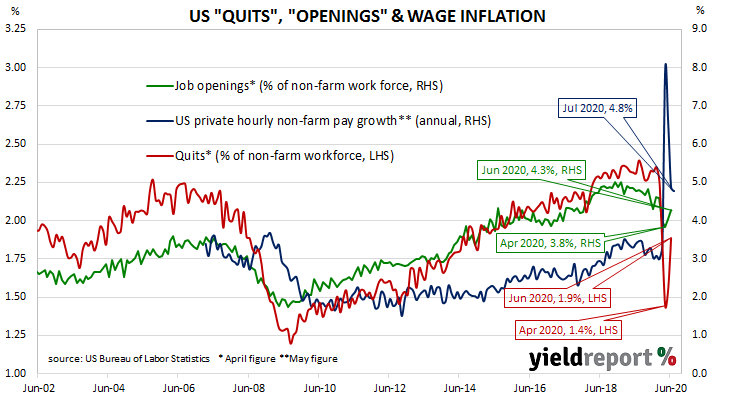Summary: US quit rate increases for second consecutive month; job openings also up; total separations up; accommodation & food sales sector largely responsible for increases in all categories; report “dated” according to some economists; number of openings “all the worse” in light of total jobless figure.
The number of US employees who quit their jobs as a percentage of total employment increased slowly but steadily after the GFC. It peaked in March 2019 and then tracked sideways until virus containment measures were introduced in March. Quit rates plummeted as alternative employment opportunities rapidly dried up.
Figures released as part of the most recent JOLTS report show the quit rate has continued to stage a recovery. 1.9% of the non-farm workforce left their jobs voluntarily in June, a rise from May’s comparable figure of 1.6%. The largest source of additional quits arose from the “Health care and social assistance”, “Accommodation & food services” and “Retail trade” sectors while the “State and local government”, “Finance and insurance” and “Federal” sectors were the only sectors to experience falls. Overall, the total number of quits for the month increased from May’s figure of 2.067 million to 2.598 million in June.
April’s non-farm payroll report indicated average hourly pay had spiked, possibly the result of fewer lower-paid jobs relative to higher paying ones. Subsequent months’ figures then saw falls in average hourly pay, with a corresponding fall in the annual growth rate from 8.0% in April to 4.8% in July.
Total vacancies at the end of June increased by 518,000, or 9.6%, from May’s revised figure of 5.371 million to 5.889 million, driven by large increases in the “Accommodation and food services” and, to a lesser extent, the “Health care and social assistance” sectors. Reduced openings in the construction and state and local government sectors provided the only drags. Overall, 16 out of 18 sectors experienced more job openings than in the previous month.
Total separations during the same period increased by 522,000 from May’s revised figure of 4.236 million to 4.758 million. The change was again led by the “Accommodation and food services” sector, where there were 175,000 more separations than in May. Separations decreased in 5 of the 18 sectors, with the state and local government sector experiencing the largest drop.

